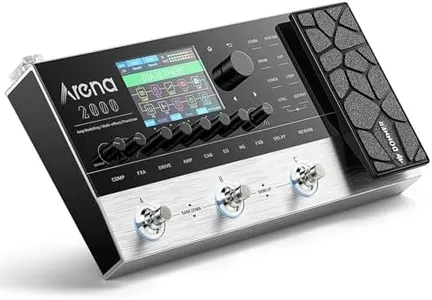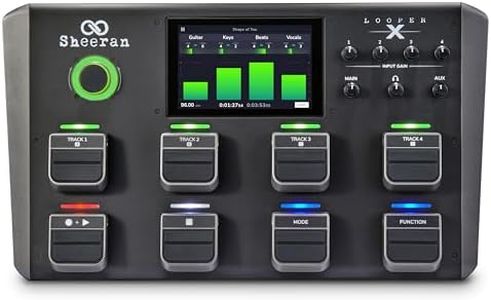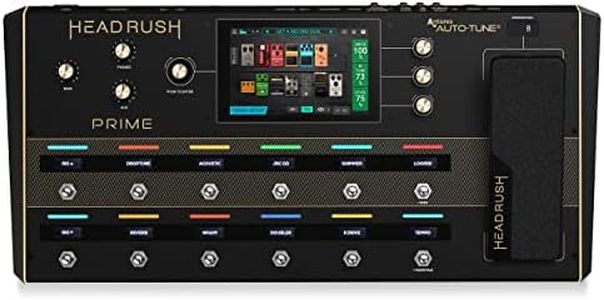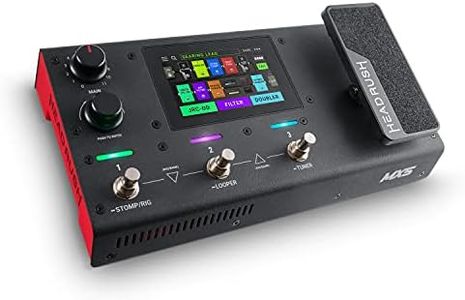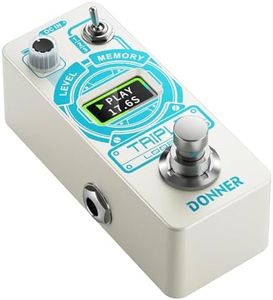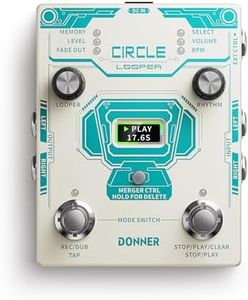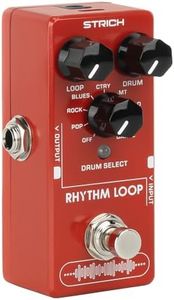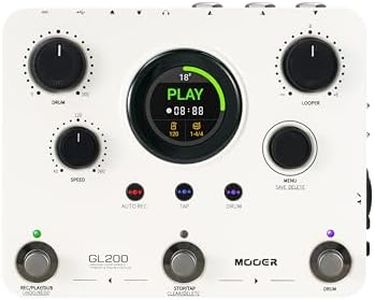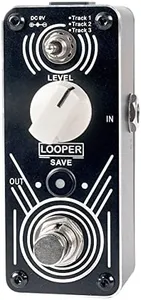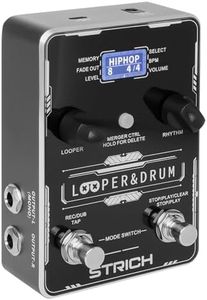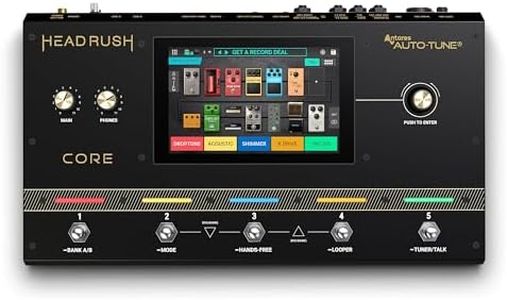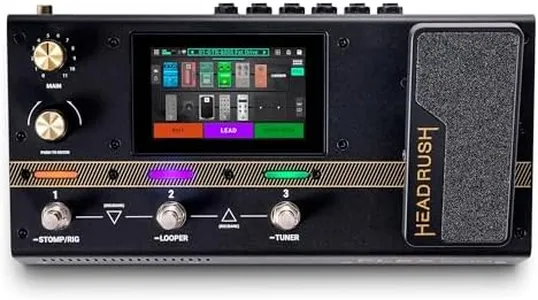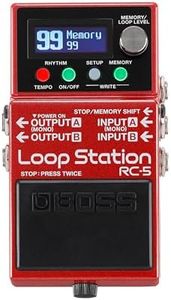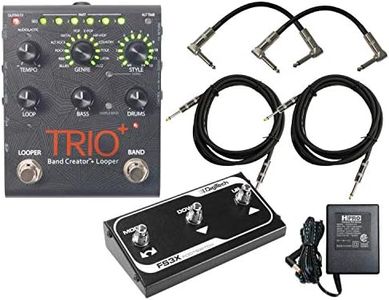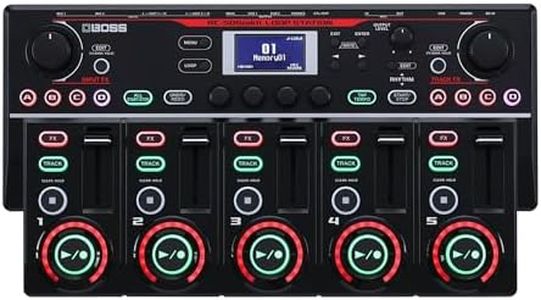10 Best Guitar Loopers 2026 in the United States
Our technology thoroughly searches through the online shopping world, reviewing hundreds of sites. We then process and analyze this information, updating in real-time to bring you the latest top-rated products. This way, you always get the best and most current options available.

Our Top Picks
Winner
SHEERAN LOOPER X Multi-Track Looper Workstation with 8 Pedals for Guitar, Bass, Keyboard, Vocals, with Touch Screen, Multi-FX Engine, Audio Interface
Most important from
160 reviews
The SHEERAN LOOPER X is a cutting-edge multi-track looper designed to cater to musicians looking for versatility and innovative features. With a 7-inch multi-touch display and 8 durable pedals, it allows for an intuitive looping experience. One of its standout strengths is its five looper modes and the ability to manage up to four tracks per loop, which can be particularly appealing for solo performers or bands wanting to layer their sounds creatively. The audio quality is impressive, utilizing a professional 32-bit sound engine, ensuring that your loops sound polished and professional.
Moreover, the extensive effects library, including 26 individual effects and 9 multi-FX racks, gives users the tools to transform their loops significantly. The device also boasts advanced connectivity options, including XLR inputs for vocals and instruments, making it adaptable for various setups, whether for live performances or studio recordings.
On the downside, the LOOPER X is relatively bulky at 16.1 pounds, which might be cumbersome for musicians needing a lightweight solution for gigs. Its price point may also deter beginners or casual users who might find simpler loopers more suited to their level. Additionally, while the device offers extensive features, new users may experience a learning curve when trying to navigate its complex functionalities and settings.
Most important from
160 reviews
Line 6 HX Stomp Multi Effects Processor, Black
Most important from
469 reviews
The Line 6 HX Stomp is a compact and powerful multi-effects processor that includes a looper function, making it suitable for guitarists looking to add looping to their setup along with a wide range of effects. It offers professional-quality audio backed by HX Modeling technology and more than 300 effects. The device can handle up to six effects blocks simultaneously, including the looper and impulse response loading for amp simulation, which is great for creating layered sounds.
The three capacitive footswitches with color-coded LEDs make it easy to control and edit loops on the fly, and the additional TRS pedal input adds flexibility for expression or switching. Connectivity options are solid, with standard inputs and outputs suitable for integrating into various setups.
The HX Stomp is an excellent choice if you want a compact pedal that combines high-quality effects with basic looping capabilities in one unit, especially for live performance or practice. It is particularly well suited for users who do not require extensive looping features or very long loop times.
Most important from
469 reviews
HeadRush Prime - Guitar and Vocal Multi Effects Pedal and Amp Modeling Processor with Amp Cloner, Antares Auto-Tune, WiFi, Touchscreen, Looper and Bluetooth
Most important from
121 reviews
The HeadRush Prime is a versatile and powerful tool for guitarists and vocalists, particularly those interested in live performances and recording. One of its standout features is the built-in looper, which allows users to create layered sounds and save loops as .WAV files for later use. This is a big plus for songwriters and performers who want to capture their musical ideas on the fly. With a robust 7" touchscreen, it provides an intuitive interface to access a vast library of guitar and vocal effects, amp models, and impulse responses, enhancing creativity during performances.
The Smart Amp Cloner feature is another highlight, enabling musicians to replicate their favorite amps and share them via Wi-Fi, which offers significant flexibility for sound experimentation. The inclusion of Antares Auto-Tune ensures that vocal performances sound polished, making it appealing for those who perform live.
In terms of connectivity, the Prime is well-equipped with multiple inputs and outputs, including XLR and 1/4" options, allowing for various setups. The durable steel chassis and customizable footswitches further enhance its usability on stage. However, weighing 7.5 kilograms, it might be less portable compared to lighter options, which could be a concern for musicians frequently on the go. The extensive feature set may also present a learning curve for users who are not familiar with complex gear, potentially making it overwhelming for beginners. While the memory and storage capabilities are impressive, some users may find they need to invest time in managing their settings and effects to fully benefit from everything the Prime has to offer. The HeadRush Prime is a fantastic option for serious guitarists and performers who seek a comprehensive solution for effects processing and looping, though it may not be the best fit for casual players or those who prefer lightweight gear.
Most important from
121 reviews
Buying Guide for the Best Guitar Loopers
Choosing the right guitar looper can significantly enhance your music creation and performance experience. A looper allows you to record and play back music in real-time, layering sounds to create complex compositions. When selecting a looper, it's important to consider your specific needs, such as the type of music you play, your performance style, and the features that will best support your creativity. Here are some key specifications to consider when choosing a guitar looper.FAQ
Most Popular Categories Right Now
